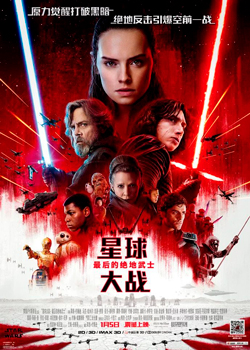“Is there anyone in the galaxy that doesn’t know the new Iron Man movie is opening on Friday?” Steven Soderbergh bemoaned during his talk on “The State of Cinema” few years ago. Much to Soderbergh’s disadvantage, his audience at the time had not fully witnessed the wave of superhero-franchise movies that would sweep them in the coming years. With Disney recently announcing more Star Wars movies from the creators of Game of Thrones, the most common reaction doing the rounds on social media has been “How many more of these movies are they going to make?!”
Soderbergh continues, “Look…I get it. The foreign market is huge nowadays. They play a big role in why a movie gets greenlight”. The biggest player in this foreign market is obviously, China. With its growing population of younger audiences and relaxed censorship rules, China has opened its door to a huge influx of big budgeted Hollywood movies.

The Last Jedi poster | Disney/LucasFilms
While the initial buzz may have set the cash registers ringing, a quick look at the last year’s box office figures shows us that these big budget movies seem to have already reached a stagnation point. One doesn’t need to look further than the recent Star Wars flick The Last Jedi for evidence. Rob Cain reports for forbes.com, “The sequel’s debut in China was less than one-third of The Force Awaken’s opening 2 years ago, and astonishingly, it even fell short of Rogue One’s opening numbers” As the scale of these franchises keep getting bigger and bigger, Hollywood already seems to be falling well short of the Chinese audiences expectations.
Wang Jianlin, founder of Dalian Wanda Group and now the world’s biggest movie theatre operator, speaking at the Davos conference last month, “China has something special. Hollywood is all about big scale screenings, US saving the world. Chinese films tend to talk about emotions, the relationships between people, which is why more and more Chinese people prefer to watch domestically produced films.” This gap in expectations has created a vacuum for quality content, that is quickly being filled by a new product, Indian movies. Although, both countries are strong rivals from a geopolitical perspective. The movie audiences share a lot of parallels. Both countries have a young burgeoning population that is rejecting the old, tried & tested formulaic movies of yesteryear.
So, what makes Indian movies more attractive to Chinese moviegoers than what Hollywood has to offer? Firstly, Indian movies have changed a lot in the last decade. The elaborate song sequences and love stories are being replaced by the demand for smaller and more personal movies. Stories that speak to the day-to-day struggles of a population that is still smack in the middle of rising from poverty to prosperity, from pastoral life to urban, from a male dominated hierarchy to a society that is grappling with challenge of accommodating equal rights for women.
Second, the depiction of these stories defying societal norms have struck a chord with Chinese audiences on both personal and emotional level. Third, the audience for these stories aren’t just limited to the big metropolitan cities but are spread all across the country. Attracting audiences across all age groups.

Dangal poster | DisneyIndia
Most recently, Dangal, the true story of two female wrestlers defying gender stereotypes on their way to winning the Olympic gold has become both a box office and cultural phenomenon. The film is lead by actor Aamir Khan, who plays a former wrestler, denied the chance to become an international champion, ends up deciding to train his daughters to vicariously fulfil his dream. Within weeks of its release, the film quickly became the highest grossing Indian film in China and grabbed a spot on the top 10 highest grossing films of 2017. The film has also sparked conversations about Feminism and the restrictions imposed upon women, “We’re not expected to get married at 14 and be tied up in family chores for life as shown in the movie, but just like these wrestlers, women in China need to work much harder to have the same standing as men in society,” said moviegoer Zhe Liu.
Dangal’s success follows a string of other Indian films PK, 3 Idiots, Dhoom 3 that have steadily won over the Chinese audiences setting box office records in the last few years. Thus proving that the success of these films weren’t mere anomalies but indicative of what Indian filmmakers can aim for in the future. This also raises questions about the tact taken by Hollywood in its wild attempt to capture the Chinese market. Can studios fix their approach and turn around their fortunes in 2018? Or will they continue on the downward spiral by betting big on franchise movies and abandoning the audience of what is soon to be the biggest movie market in the world?

